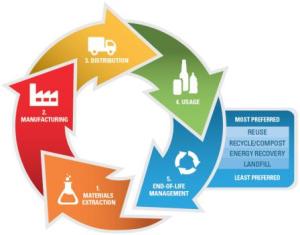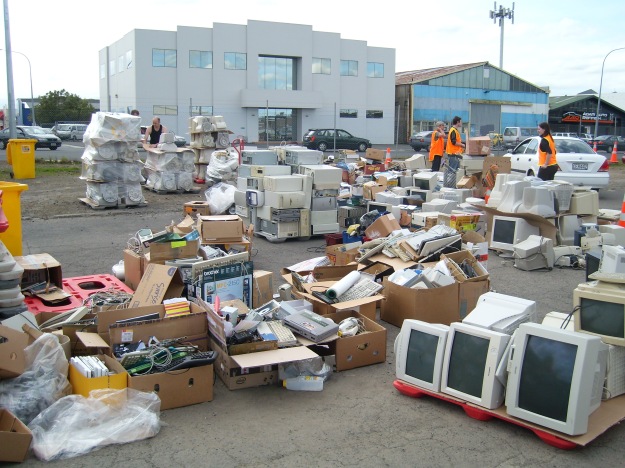A guest post by Erica K. Brockmeier
The following post is one of a series generated from research presented at the SETAC Europe Annual Meeting in Brussels, Belgium (7-11 May 2017). Each post features the latest research findings from SETAC scientists on emerging topics of interest.
Circular economy, LCA, and the environment

General materials life cycle. Credit: , accessed from: .
As we consumers become more aware of how the products we buy and use impact the health of the environment, companies are also looking for ways to make more sustainable products using materials with a more positive environmental impact. Life cycle analysis (LCA) is a way for environmental scientists to the environmental impacts of a material or product. A is a system of production and consumption that is powered by renewable energy. A clean circular economy also focuses on eliminating toxic chemicals and closing material loops through better design, maintenance, repair, reuse, refurbishing, and recycling.
An LCA includes everything that goes into the creation of a consumer product: gathering raw materials (like wood, coal, or metal), manufacturing the product (the type of factory used, what energy goes into production), how the product is used (single use versus multiple uses), and what happens to the product when it is no longer needed (what components are disposed or recycled). An LCA is completed using : 1) inventory analysis (identify all inputs and outputs, where materials come from, where they end up, and the energy inputs and outputs related to the creation of the product), 2) impact analysis (a value known as an ‘impact score’ indicates the impact of each step in the manufacturing process), and 3) improvement analysis (finding places in the process that can be improved to reduce the impact score, like using less energy).
LCA helps companies understand what they can do to make products more sustainable, reduce negative impacts on the environment, and produce less toxic by-products. Product manufacturing is extremely complex however: raw materials are sourced from around the world, all of which are obtained in different ways depending on the country of origin and the type of material. Companies are constantly looking for better ways to determine the sustainability of new products.
At the SETAC held in May 2017, researchers presented the latest advancements within LCA towards solving real-world problems in sustainability. Here we highlight the findings from the special session “Think-Outside-The-Box-Session: Clean circular economy: recycling while eliminating legacy toxics” organized by Dr. Niels Jonkers (Ecochain) and Dr. Heather Leslie (VU Amsterdam). We also highlight a selection of platform presentations from the “Advancements in life cycle impact assessment and footprint method development” session chaired by Serenella Sala (Joint Research Centre).
Creating a clean circular economy
Sicco Brandsma from VU Amsterdam highlighted the science behind recent health concerns on the use of recycled tires and rubber for recreational fields. Nearly 90% of all artificial soccer fields in countries like the Netherlands are made of recycled rubber granules, and a single playing field can use up to 20,000 recycled tires. EU regulations currently limit the amount toxic chemicals, such as polycyclicaromatic hydrocarbons (PAHs) that can be found in recycled rubber on playing fields to 100 mg of chemical per kg of rubber material. But Brandsma pointed out that regulations for other rubber products, such as children’s toys and rubber playground flooring require much lower maximum concentrations of PAHs, closer to the 1 mg/kg range. Brandsma highlighted the need for further research in this area that can address the concerns consumers have about the presence of rubber in places that people come into contact with on a regular basis.

“Rubber crumb” on an artificial turf playing field. Credit: , .
Jane Muncke (Food Packaging Forum Foundation) gave a perspective from the food packaging industry on the future of the circular economy. Food consumption makes up close to one third of all human-induced environmental impacts across the world. Part of this impact is due to waste from food packaging, and the industry is attempting to address these challenges while making sure that chemicals used in food packaging are not toxic. There are currently 8,000 chemicals regulated by the EU in food packaging materials, but Muncke said that monitoring all 8,000 chemicals and understanding how the manufacturing process impacts chemical composition remains a challenge.

Credit: , accessed from , .
Muncke highlighted the importance of food package recycling in order to achieve a complete circular economy but stressed that material recycling should not be done in a way that increases human contact with potentially hazardous chemicals. Proposed solutions include ensuring that food containers are recycled but then reused in a manner consistent with their original purpose, such as reusing cold food containers to hold cold food again and not hot food (where the heat could cause some of the chemicals to leech out).
Giorgia Faraca (Technical University of Denmark) talked about on finding safe ways to recycle and reuse wood products. The challenge in this area is the presence of impurities in wood, such as metals, plastics, and chemical additives including paints and oils. There are EU regulations in place to prevent contact with hazardous materials in recycled wood, but Faraca stated that these regulations also make it a challenge to ensure that high-quality wood materials can be reused instead of simply thrown away. Faraca and her team found that some chemical impurities could be removed completely before recycling. She commented that while some impurities may still occur in recycled wood materials, low enough levels ensure that the material could still be used safely by consumers.
Arthur Haarman from EMPA Technology and Society Lab discussed work on electronic waste. Electronic waste (e-waste) is a fast-growing waste stream in the developing world that includes materials such as used computers and television sets. This waste stream is attractive to recyclers because it contains valuable minerals like copper. However, this waste stream also includes highly toxic materials such as flame retardants and heavy metals. Haarman said that of the 42 million tons of e-waste generated in 2014, only 15% of materials entered a formal and proper recycling and waste treatment process. Haarman then discussed e-waste in India, where informal regulations and cultural perspectives can lead to unsafe handling of hazardous materials. There are ways for recyclers in India to handle plastic contaminated with toxic chemicals, but Haarman reported that the initiatives for recyclers to undergo additional separation steps are not working. Haarman and his group studied the trends of e-waste recycling in India and developed a strategy, coupled with easy-to-use testing methods, that provides greater incentives for removing toxic chemicals from e-waste.

E-waste recycling. Credit: Floyd Wilde, CC BY-SA 2.0.
New advances in LCA
Caroline Catalan (I Care & Consult) presented new LCA methods for measuring a product’s impacts on biodiversity. Once finalized, this new LCA method will be able to measure how different versions of a product relate to measures of ecological richness. This method will provide a way to calculate the total ecological footprint of a product, providing a new way for companies to use LCA to ensure that their products are sustainable. Catalan also hopes that the results of this project will provide a connection between ecologists and LCA researchers that is both scientifically and economically sound.

Wooden pallets. Credit: , .
Mathilde Vlieg (Evah Institute) discussed a case study aimed at calculating carbon credits from wood products. Vlieg emphasized the importance of accounting for carbon storage during LCA because of the ability for timber products to uptake carbon before harvest. This carbon remains stored if the materials are recycled, and carbon is released back into the environment if they are burned or allowed to decompose. Vlieg presented data from suppliers and manufacturers, with endpoints including forest age and fire history to calculate carbon sequestration. Long-term models developed for this LCA showed that up to 90% recovery of wood materials is possible even after 60 years of use. These results provide further support to the study of carbon sequestration potential of wood materials and their application in LCA.
Karoline Wowra (TU Darmstadt) discussed the importance of nitrogen in LCA. An over-abundance of nitrogen from agricultural or fossil fuel production can lead to eutrophication, algal blooms, and oxygen depletion in freshwater ecosystems. Many LCA models already account for nitrogen levels but there are many regional differences in nitrogen levels and cycles. Wowra’s group compared different LCA methods to see if nitrogen levels were being incorporated accurately. She found that the specific nitrogen compounds studied and the geography of the region influenced how applicable the existing LCA methods were for a particular area under consideration. Wowra suggested that researchers select LCA methods depending on the goal or scope of the study, for example, an LCA focused on agricultural impacts should include more accurate measurements of specific nitrogen compounds relative to agricultural soil.
Bernard De Caevel at RDC Environment examined using a resource’s market price as a basis for its value within LCA. This project focused on the use of a non-renewable resource’s monetary value as a proxy for that resource’s environmental value. De Caevel and his team found that a material’s market price can be a valid substitute for determining value, but that social and market forces on a resource’s price still needs to be taken into account. His group will continue to develop other ways to determine the value of minerals and fossil reserves for completing LCAs on products which use those non-renewable resources.
What’s next for life cycle analysis, circular economy, and SETAC?
LCA is just one way that science is helping companies make greener products for consumers looking for safe and sustainable products. The SETAC Brussels meeting provided a forum for these researchers to discuss the challenges and considerations needed to apply these methods to address real-world challenges. SETAC will continue to play a role in the future of LCA as a place for researchers in the field to work together towards making the vision of a clean circular economy a reality.

Very useful compilation. Thanks for sharing.